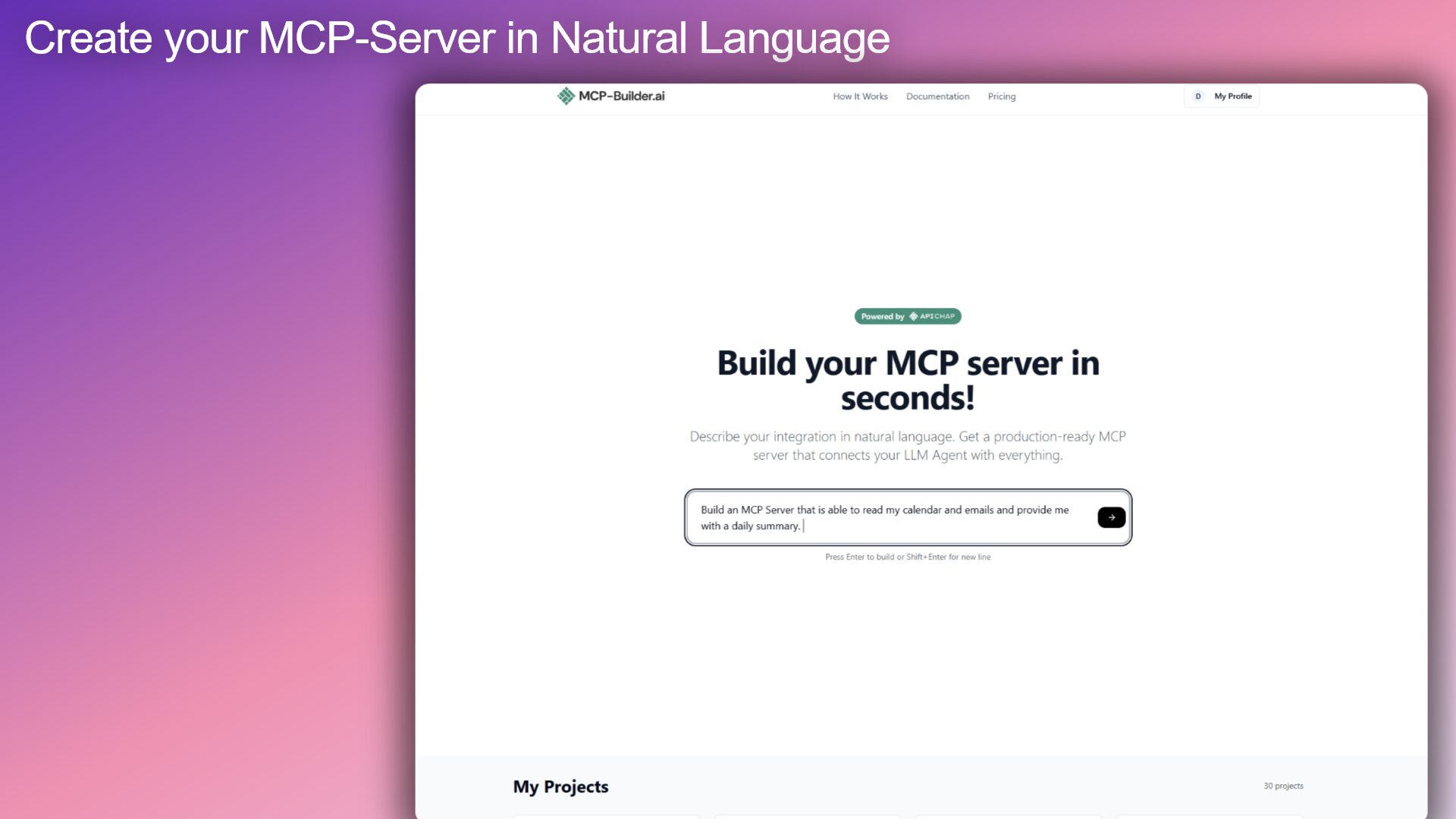
Table of Contents
Overview
Tired of wrestling with custom server setup and plumbing AI agents into your stack? MCP-Builder.ai transforms that entire process into a simple conversation. Describe your desired integrations and workflows in plain English, and the platform instantly generates a fully featured MCP server that connects your LLM agent to any data source or service. You get production-ready code with built-in error handling, authentication, monitoring, and real-time synchronization—deployable either on MCP-Builder.ai’s global cloud or on-premises behind your firewall.
Key Features
MCP-Builder.ai blends no-code simplicity with enterprise-grade robustness:
- Natural language-based server setup: Describe your data sources, API calls, file formats, authentication, and workflows in plain English.
- No coding required: The AI engine auto-generates and configures all connectors, IAM scopes, and logic without writing a line of code.
- Connect Any Data Source: Seamlessly integrate REST APIs, databases, file systems (including CSV or XML files), cloud services, FTP endpoints, and more.
- Production Ready: Includes built-in testing harnesses, error-handling routines, OAuth-style authentication flows, and usage monitoring dashboards.
- Instant Deploy or On-Prem: One-click deployment to MCP-Builder.ai’s managed cloud, or export and run within your own infrastructure for full data sovereignty.
- Real-time Sync: Your MCP server automatically watches for schema or API changes and keeps connectors up to date.
- Flexible Scalability: Scale from a single endpoint to enterprise-grade clusters handling thousands of agent requests per second.
How It Works
- Describe your integration in the web editor using natural language.
- Upload or point to API specs, database schemas, or file definitions that you need to connect.
- Review and adjust the generated server logic in the integrated preview environment.
- Deploy with a click—either to MCP-Builder.ai’s managed infrastructure or export Docker-ready artifacts for your own cloud or on-premises deployment.
Behind the scenes, an LLM parses your instructions, stitches together JSON-RPC tool definitions, wraps in authentication flows, generates connector modules in your language of choice, and wires up tests and monitoring hooks.
Use Cases
MCP-Builder.ai is ideal for teams that need to spin up backend integrations and AI agents without a full engineering cycle:
- Enterprise automation pipelines: Automate order processing, invoice reconciliation, HR onboarding, or any custom workflow by hooking your agent into ERP, CRM, and internal APIs.
- IT and data engineering: Build unified data-integration endpoints for BI dashboards or LLM-powered analytics without manual ETL coding.
- AI assistant backend: Rapidly configure and iterate on the tool set for your chatbots or autonomous agents, allowing them to read and write across systems.
- R\&D prototyping: Test novel agent-driven ideas by standing up complete environments in minutes, then promote to production with confidence.
- Internal operations tooling: Empower non-engineering teams to define and deploy backends for reporting, alerts, and automated tasks.
Pros \& Cons
Advantages
- Natural language interface: Empowers business analysts and product managers to define backends without developer intervention.
- Enterprise-grade readiness: Instant inclusion of monitoring, security best practices, and test suites.
- Broad protocol support: Connects to REST, SQL/NoSQL databases, file systems, FTP, and cloud storage services.
Disadvantages
- Frontend UIs require external tools: The platform focuses on backend logic; building user interfaces still needs a separate frontend framework.
- Validation for mission-critical systems: Highly complex or regulated deployments may still benefit from a technical audit of the generated server code.
How Does It Compare?
MCP-Builder.ai occupies a unique niche in the no-code AI integration space. Here’s how it stacks up against leading alternatives:
| Platform | Deployment Model | Integration Focus | Coding Required |
|---|---|---|---|
| Zapier | Cloud-only | Workflow automation across SaaS apps | Minimal scripting |
| Xano | Cloud or self-hosted | No-code backend APIs and database logic | No code for simple use; custom code optional |
| Postman AI Tool Builder | Cloud-only | Generate MCP servers from public APIs; customizable in code | No code generation; server code can be extended |
| BuildShip | Cloud-only | Visual workflow builder with AI-generated integration nodes | No code for workflows |
| MCP-Builder.ai | Cloud or on-prem export | AI-native MCP servers with built-in test, monitoring, real-time sync | Zero code for complete backend |
- Unlike Zapier, which orchestrates high-level SaaS workflows, MCP-Builder.ai focuses on creating custom server environments that allow LLMs to execute deep logic and maintain state.
- Compared to Xano’s general-purpose no-code backends, MCP-Builder.ai is purpose-built for LLM integration, auto-generating JSON-RPC tool interfaces and agent connectors.
- Postman’s AI Tool Builder can scaffold MCP servers from existing public APIs, but extending and securing those servers still requires manual coding; MCP-Builder.ai delivers fully production-ready servers out of the box.
- BuildShip provides AI-assisted workflow nodes, but does not bundle monitoring, OAuth, or real-time schema sync; MCP-Builder.ai includes those for enterprise reliability.
Final Thoughts
MCP-Builder.ai redefines how backend infrastructures for AI agents are built—turning weeks of engineering work into minutes of conversation. Its natural language setup, production-grade feature set, and flexible deployment options democratize backend development for LLM applications. For organizations aiming to fast-track AI-powered workflows without sacrificing security, scalability, or monitoring, MCP-Builder.ai delivers a standout solution.

